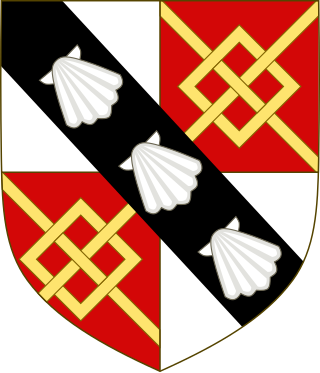
The Spencer family is an aristocratic family in the United Kingdom. From the 16th century, its members have held numerous titles, including the dukedom of Marlborough, the earldoms of Sunderland and Spencer, and the Churchill barony. Two prominent members of the family during the 20th century were Sir Winston Churchill and Diana, Princess of Wales.

Spencer Compton, 1st Earl of Wilmington, was a British Whig statesman who served continuously in government from 1715 until his death in 1743. He sat in the English and British House of Commons between 1698 and 1728, and was then raised to the peerage and sat in the House of Lords. He served as the prime minister of Great Britain from 1742 until his death in 1743. He is considered to have been Britain's second prime minister, after Robert Walpole, but worked closely with the Secretary of State, Lord Carteret, in order to secure the support of the various factions making up the government.

Marquess of Northampton is a title that has been created twice, firstly in the Peerage of England (1547), then secondly in the Peerage of the United Kingdom (1812). The current holder of this title is Spencer Compton, 7th Marquess of Northampton.

Edward Somerset, 4th Earl of Worcester, KG, Earl Marshal was an English aristocrat. He was an important advisor to King James I, serving as Lord Privy Seal.

Spencer Compton, 2nd Earl of Northampton, styled Lord Compton from 1618 to 1630, was an English soldier and politician who sat in the House of Commons from 1621 to 1622. He became a peer by writ of acceleration in 1626 and by inheritance in 1630. He fought in the Royalist army and was killed in action at the Battle of Hopton Heath.

Grey Brydges, 5th Baron Chandos of Sudeley Castle in Gloucestershire, was an English nobleman and courtier.
The title Baron Bergavenny was created several times in the Peerage of England and once in the Peerage of Great Britain, all but the first being baronies created by error. Abergavenny is a market town in South East Wales with a castle established by the Norman lord Hamelin de Balun c. 1087.
This is an incomplete list of people who have served as Lord Lieutenant of Warwickshire. Since 1728, all Lord Lieutenants have also been Custos Rotulorum of Warwickshire.

Baron Compton is an abeyant title in the Peerage of England, meaning that inheritance of the title stopped because there was no legal priority as to which daughter would inherit the title. The title was created in 1572 for the Tudor politician, Sir Henry Compton. In 1618, his son was created Earl of Northampton. The titles remained united until the fifth earl died without any male heirs in 1754 and the title passed to his only daughter, Charlotte, who had already inherited the title of Baroness Ferrers of Chartley from her mother in 1740. Charlotte was the wife of Hon. George Townshend, who became Viscount Townshend in 1764 and was created Marquess Townshend after her death in 1770. The title then remained with the marquessate until her grandson, the third marquess, died childless in 1855 and both baronies became abeyant between his sisters and their descendants.
Henry Nevill, de facto 9th Baron Bergavenny was an English iron founder, soldier and politician who sat in the House of Commons at various times between 1601 and 1622 when he inherited the Baron Bergavenny peerage.

Francis Hastings, 2nd Earl of Huntingdon, KG was the eldest son of George Hastings, 1st Earl of Huntingdon and Anne Stafford, Countess of Huntingdon, the ex-mistress of Henry VIII.

William George Spencer Scott Compton, 5th Marquess of Northampton, KG, known as Lord William Compton from 1877 to 1887 and as Earl Compton from 1887 to 1897, was a British peer and Liberal politician.
Henry Compton, 1st Baron Compton, was an English peer and Member of Parliament.

William Spencer, 2nd Baron Spencer of Wormleighton was an English nobleman, politician, and peer from the Spencer family.

Robert Spencer, 1st Baron Spencer of WormleightonKG was an English nobleman, peer, politician, landowner, and MP from the Spencer family.

John Mordaunt, 1st Earl of Peterborough was an English peer.
Hon. Sir Edward Herbert was an English politician and landowner. His aunt, Katherine Parr, was the sixth, and final, wife of King Henry VIII.
Sir John Spencer was a successful English merchant and Lord Mayor of London.

Anne Sackville, Countess of Dorset, née Anne Spencer, was the second wife of Robert Sackville, 2nd Earl of Dorset. Dorset was her third husband, the first two being William Stanley, 3rd Baron Monteagle, and Henry Compton, 1st Baron Compton, both of whom predeceased her.














